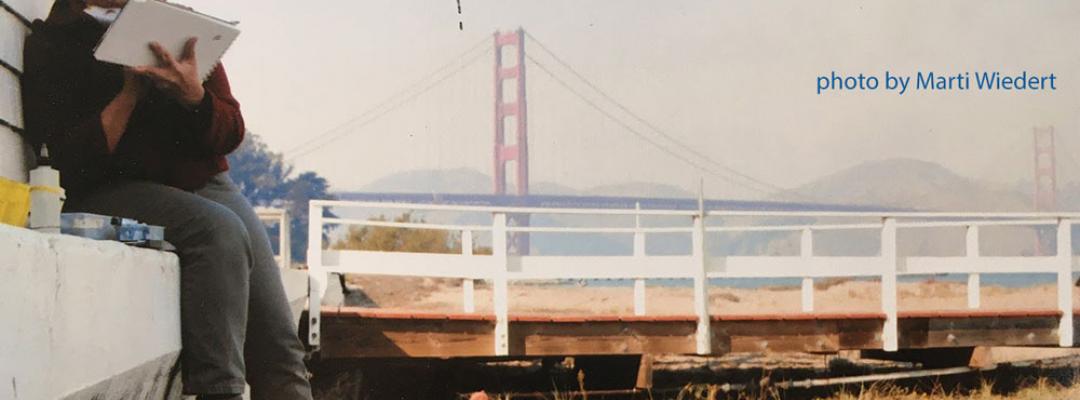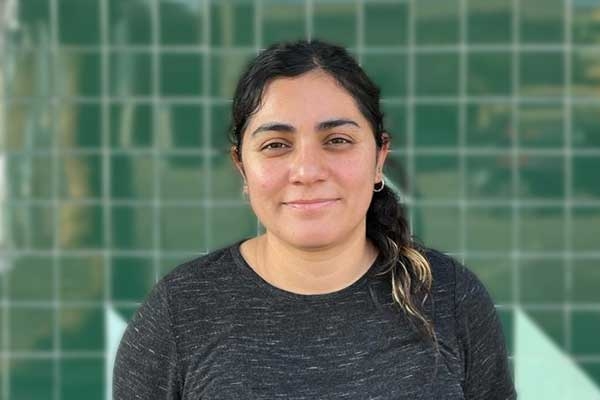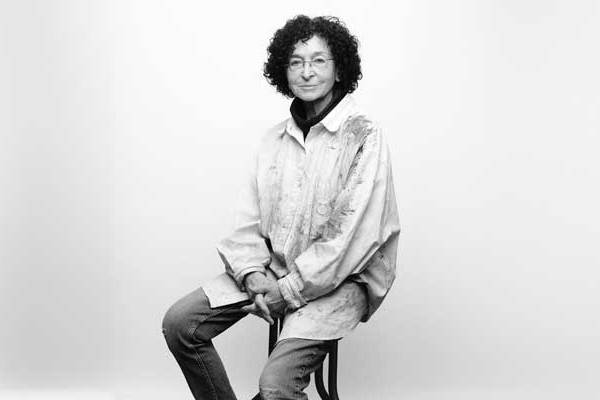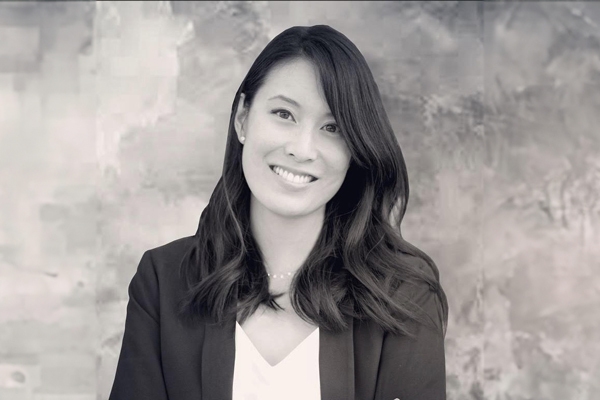When you listen to Jennifer Mahoney, it’s instantly clear that she deeply respects her design students as goal-oriented strivers.
As Jennifer describes her students, “They've already been down the road and made a couple life choices. Now they are changing their minds. They are more open and genuinely curious. And they might be paying for it themselves, or be responsible to their boss or family or partner for paying for it. Motivation is super high for Extension students.”
That she wants to engage her students' curiosity is just one of the reasons Jennifer was selected as a 2020 Inspirational Instructor. She also has contributed her professional expertise, wide-ranging interest base and intellectual talents during her decades-long run as one of our esteemed instructors.
Starting Off With Intellectual Curiosity
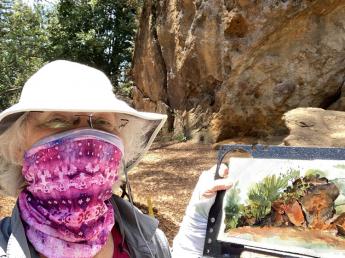
Jennifer always loved to draw, so majoring in Fine Arts at Indiana University was a clear call. As testament to her breadth of intellectual curiosity, she decided to pursue a double major, adding Slavic Studies to her academic workload. She’d studied Russian in high school, "the alphabet looked different,” and—at the time—the ongoing Cold War made it seem like a more marketable major than art.
Those intellectual forays into linguistics echo throughout her drawing practice. “When you put a line across a page, it can be a figure on the ground or an indication that what is on one side is different somehow from what's on the other side,” she explains. “As you put more lines on the page, the meaning they carry grows more complex. You can look at the building blocks of language in the same way. From phoneme to poetry, we put sounds together to express ourselves or convey ideas.”
Making a Living Drawing
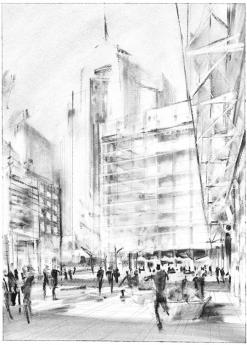
As it turns out, Jennifer had no problem making a career out of listening and drawing. Armed with formidable skills in rendering, sketching, interpretation and conceptualization, she filled a niche practice of design development and presentation strategy, J.F. Mahoney Illustration. She built a solid client base visualizing their ideas and moving them forward, sketching visual narratives and creating finished products in a variety of media.
Some of her longer-term relationships include Gap Inc. parent company, Gelfand Partners Architects, local branding agency Tesser, and STUDIOS Architecture. For the past 20 years, a workload grown via word of mouth has been enough.
And the words are, of course, highly complimentary. “Jennifer's sensibilities in the selection of viewpoint, scale and composition artfully convey a sense of what the space will truly be. Her vast knowledge of tools, materials and techniques—both computerized and traditional—is a valuable asset to any project,” enthuses architect Jim Stetson.
Jennifer also shares a brief but telling recommendation that snared her a staff project visualization gig at a large tech tech firm:
“Jen is fab.”—Louis Schump
At this point in her career, she enjoys continued collaboration with clients whose goals align with hers and spreads out her time between work, teaching and volunteering.
Impressive Roster of Volunteer Ventures
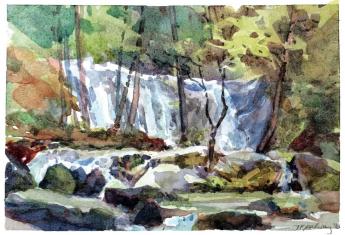
Jennifer isn’t just a being of pen, pencil, charcoal and stylus. As an outgrowth of her artistic practice, she has crafted a lifetime of outdoor activities. She has volunteered for Bay Area Ridge Trail Council putting in hours for donor development and hands-on support for hikers.
She’s also gotten her hands dirty on trail maintenance in Lassen National Park under the auspices of the Sierra Club.
Perhaps her most notable volunteer accomplishment is training wilderness first responders and first-aiders through Foster CalmSM Wilderness & Leadership Training. Jennifer refers to her 10 years of experience in this venture as being a member of the “Department of Being Prepared.”
“Volunteering as a wilderness first responder introduced me to the beauty and dangers of the UNBUILT environment,” Jennifer shares. “I’ve learned that improvisation is a good crossover skill, and that it's crucial to prioritize safety and preparedness; that alone greatly improves outdoor experiences. It's an equally important prescription for the built environments we are conceiving today for ourselves and others.”
Jennifer well understands that volunteering not only helps you do good (it helps you do well yourself in your other endeavors).
Oh Yeah, and She Teaches
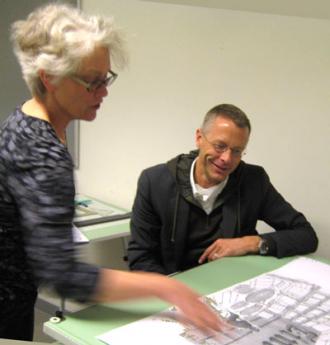
All of these notable accomplishments, and we haven’t even mentioned teaching!
During her 25 years of teaching for us (spread out over two distinct stints), Jennifer has lent her professional expertise in guiding her students’ artistic visions in Design Communication II, Design Communication III and Sketching for Interiors. Throughout all of her instruction, she combines in-class curricula, one-on-one work and practical field trips.
One of our strengths is that our students come from different age groups, life experiences, goals and skills. For our instructors, that diversity becomes a challenge itself. And Jennifer is no exception: She has students who love to draw and those who are intimidated by putting pencil to paper.
So one of the first exercises that she puts before her students is to draw a horizontal line. Sounds simple enough, sure, but this exercise gains weight and importance.
“It's like so many creation stories in that everything on one side is heaven and the other is earth, yet they've only drwn one line. Students will understand the dividing heaven and earth part,” Jennifer explains. “The next thing is to leverage gravity, sense the weight of things, establish the figure/ground, see the 90-degree vertical relationship between the ground and things that project up from the ground.”
Just in those brief sentences, you can see how Jennifer builds up a drawing from line to image to depth. Of course, it’s not that easy when you’re a student trying to master these skills. That’s where Jennifer shines, in carefully tailoring her approach for each student.
Be Blunt About It
Jennifer reminisces about a student who was struggling with freehand design drawing. While Jennifer wanted to draw out that student’s instincts, this student insisted on using a ruler because making straight lines with a sharp pencil felt safest. Jennifer wanted her to find a more expressive style, and suggested she “try a blunter instrument!”
The student switched to a magic marker. Jennifer reminisces, “That might have been her exasperation, saying, ‘Alright, here’s a blunter instrument.’ She got out a magic marker. She drew this line with quick, sketchy gestures of what she wanted. It was her innate, expressive self coming out. And the next thing you know, it's pinned up on the board with everybody else’s.
“And she said, ‘That's OK. That's exactly it.’ And from that point on, she decided all her presentations would be done in a calligraphy-type move. I couldn't praise her enough. She was still the person who wants to figure out every little corner, but she realized it's also okay to launch your idea with a bold gesture.”
Thinking and Expressing
Jennifer really wants her design students to marry their innate style with what she calls their “thinking style.” Usually, the struggle is to get in touch with their natural style. To that end, Jennifer often includes an early exercise in blind-contour drawing.
As Jennifer puts it, “A blind contour drawing is where you look at an object over there and then you put your paper over here, and you draw it, but you never look at your paper. That eliminates the part of the feedback loop where your brain says, ‘That doesn't look right.’ The blind contour drawing has a different effect; there's no judgment in it.”
Then, when they’ve gone further through the class and learned to do more complicated drawings that involve perspective (and thought), “You can hold those different drawings up to the class, and say, ‘This is your innate style that doesn't have your mind intruding, and this is your thinking style.’”
Taking It Outside
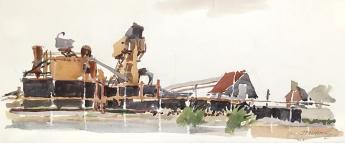
With so much teaching experience, Jennifer has some tried-and-true tactics to help her students find their drawing “voice.” One of her favorite techniques is to take students on site visits around San Francisco.
Partly because she enjoys sketching the city so much. She smiles as she remembers some of her early trips.
“San Francisco’s waterfront south of Market was a big vacant lot,” Jennifer remembers. “I would wander there, and I felt like I was in some sort of movie—a solitary figure on the flat waterfront with all these cranes and dry docks and abandoned factories.
“The wind and fog were something to battle with. I used as big a paper as I could carry. That filled the bill for me,” she says with a chuckle.
In addition to providing her with lots of urban vistas to sketch, Jennifer’s peregrinations through the city also gave her a unique perspective into—well, the art of perspective.
“I had perspective lesson after perspective lesson of how to get this stuff on the page,” she remembers. “And I knew that it would be colored by the difficulty of the climate conditions. So I had to develop a workaround for all of that, which is great because I have a lot of tips for students.
“The city scene is wrapping around me. I want to draw it on this flat piece of paper,” she continues. “So immediately, I have to reduce all the data over the time it takes to turn my head from left to right, that data reduction of three dimensions into two dimensions on a flat surface. I'm making those decisions of what to leave out.”
Putting Real Life on the Page
These drawing excursions also put a stamp of practicality on her students’ drawings. Jennifer knows the satisfaction of putting what exists in front of her eyes onto a flat piece of paper. She tells her students, “You've had this theory and you've tried it on a piece of paper looking at nothing. And now let's go look at a real space and see what the effect is.”
The reaction from her students? “It's usually pretty overwhelming, but I’ve given them a procedure to follow. ” Jennifer shares. “They're exerting hard, but when they're finished they're super-happy.”
The general reaction from her students is “incredible sketcher” and “brilliant instructor.” One recent student raved about the experience: “Jennifer is so talented, passionate and effective in teaching her skills to the students. I only wish the class was longer so I could continue to work on my sketching skills.”
Own Your Art
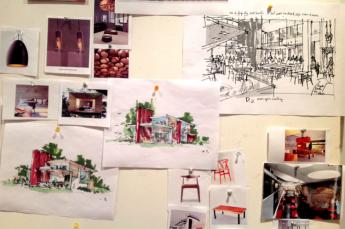
Perhaps Jennifer’s best advice to her students is this: “You're the boss of your drawing. You're always the boss of your drawing, no matter how much your client is hanging over your shoulder going, ‘No, no, no, put that there.’”
That advice rings out more strongly coming from someone who has accomplished so much and still continues to take charge of her career and life. It’s an honor to recognize Jennifer Mahoney as a 2020 Inspirational Instructor.
